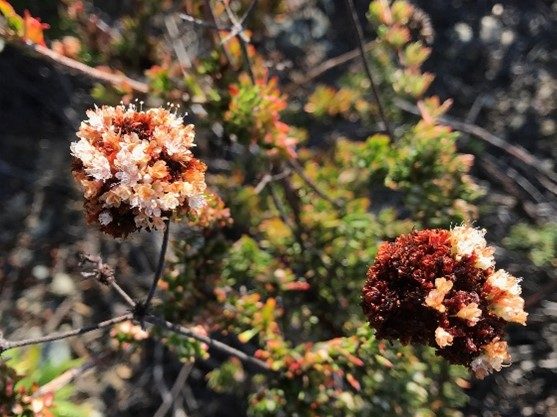
An Ecologist’s Guide to Connecting with Nature: Winter Edition
February 10, 2021
Great Ecology Wins EBJ Project Merit Award for Treatment Wetland Design
March 2, 2021
Salvaged black sage

Young white sage plants flagged for salvage

California Buckwheat
Field Blog: San Diego County Coastal Sage Scrub Plants
Author: Meghan Bowen
As part of our current San Marcos Highlands Habitat Restoration & Implementation project in San Marcos, CA, Great Ecology has been identifying and salvaging coastal sage scrub (CSS) plants for future onsite restoration. Our ecologists spend their time in the field identifying and flagging small or young, good quality plants that can be transplanted and thrive in our designated restoration areas. Once the plants have been dug up with the root system intact, they are placed in a laydown area where they can be potted, stored, and watered until the restoration phase.
Sage scrub habitats are present along the entirety of California’s coast, and support a wide variety of native plants and wildlife. Curious which plants we're selecting? Here are some common CSS plants we’ve recently seen out in the field!
Descriptions partially sourced from Calscape, and photos taken by Associate Ecologist Meghan Bowen.
1) Black sage (Salvia mellifora) – Black sages grows quickly and in a variety of soil types, making it one of the most common features in its eponymous sage scrub habitat. It can grow up to six feet high and ten feet tall. The plant is highly aromatic with a slightly minty smell. Flower colors vary from white, to pale blue, to lavender, or (rarely) to pale rose. Black sage flowers are important food sources for butterflies and hummingbirds, and the seeds are eaten by quail and other birds.
2) White sage/Bee sage (Salvia apiana) – Another staple of the CSS habitat, this sage variety is found throughout Southern and Baja California. True to its name, the underside of the plant is pale blue or white. Younger plants tend to be greener and turn whiter as they mature. White sage is highly fragrant and often used in cleansing rituals or incense. Native peoples of California utilize white sage in a variety of ways for food, medicine, ceremonies, cleansing, and sleeping.
3) California Buckwheat (Eriogonum fasciculatum) – A keystone species for sagebrush scrub ecosystems, buckwheat is native to the southwestern United States and northwestern Mexico. It can grow on slopes and dry washes in a variety of habitats, including scrub, grasslands, and chaparral. Buckwheat can grow as a patchy, compact bramble or as large, sprawling spreading bush. Flowers appear in dense clusters of pink and white, which turn red as they senesce. Each individual flower is quite small (only a few millimeters across). This plant is an important source of honey for bees, and a nectar source for bees and butterflies during dry months.
4) Deerweed (Acmispon glaber) – A nitrogen fixing plant, deerweed is a pioneer species found in dry areas of California, Arizona, and Mexico. It is commonly found across habitats like chaparral, scrub, roadsides and other disturbed areas at lower elevations. The plant blooms from March to August and has flowers that are small, yellow, and clustered together. Similar to California buckwheat, deerweed flowers turn red with age.
5) Wishbone bush (Mirabilis spp) – Also known as California Four O’clock, this species is a perennial herb that grows in Southern and Central California. It tends to grow in grassy places, although we observed a few within CSS habitat at our restoration site. The plant produces lots of small pink and purple flowers. The plant sometimes goes deciduous in the summer, leaving behind white twigs until next spring.
6) Coast prickly pear (Opuntia littoralis) – A common cactus variety native to southern California and Baja California, it grows in large, dense clumps within coastal sage scrub and chaparral habitats. The branches are made up of oval-shaped flat segments (usually referred to as “paddles”) up to 22 centimeters long. The flowers are yellow or red, which form a large purple fruit at the tips of the paddles. Prickly pear cacti provide both food and shelter to rodents, reptiles, birds, deer, and rabbits.

Deerweed growing above black sage

Mirabelis bush - the flowers will open soon!

Senior Ecologist Dr. Jill McGrady, bravely salvaging a paddle from a prickly pear cactus!

